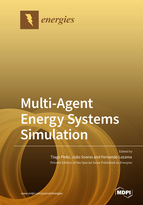Multi-Agent Energy Systems Simulation
A special issue of Energies (ISSN 1996-1073). This special issue belongs to the section "F: Electrical Engineering".
Deadline for manuscript submissions: closed (31 October 2019) | Viewed by 29033
Special Issue Editors
Interests: artificial intelligence; automated negotiation; electricity markets; energy systems simulation; machine learning; multi-agent systems; smart gridsn, machine learning, multi-agent systems, smart grids
Interests: energy resource management; energy systems simulation; electric vehicles; metaheuristic optimization; smart grid; swarm intelligence
Special Issues, Collections and Topics in MDPI journals
Interests: computational intelligence; energy resource management; energy systems simulation; evolutionary computation; local energy markets; multi-agent systems; smart grids
Special Issues, Collections and Topics in MDPI journals
Special Issue Information
Dear Colleagues,
The synergy between artificial intelligence and power and energy systems is providing promising solutions to deal with the increasing complexity of the energy sector. In particular, multi-agent systems are widely used to simulate complex problems in the power and energy domain, as they enable the modelling of dynamic environments and the study of the interactions between the involved players. Multi-agent systems are suitable not only to deal with problems related to the upper levels of the system, such as the transmission grid and wholesale electricity markets, but also to address challenges associated with the management of distributed generation, renewables, large-scale integration of electric vehicles, and consumption flexibility. Agent-based approaches are also being increasingly used for control and to combine simulation and emulation, by enabling the modelling of the details of buildings’ electrical devices, microgrids, and smart grid components.
This Special Issue brings together the latest advances and trends in multi-agent energy systems simulation. Contributions are welcome on all kinds of agent-based solutions for power and energy systems, including both theoretical multi-agent models and practical applications. We invite papers on innovative technical developments, reviews, and case studies related to multi-agent energy systems simulation.
Dr. Tiago Pinto
Dr. João Soares
Dr. Fernando Lezama
Guest Editors
Manuscript Submission Information
Manuscripts should be submitted online at www.mdpi.com by registering and logging in to this website. Once you are registered, click here to go to the submission form. Manuscripts can be submitted until the deadline. All submissions that pass pre-check are peer-reviewed. Accepted papers will be published continuously in the journal (as soon as accepted) and will be listed together on the special issue website. Research articles, review articles as well as short communications are invited. For planned papers, a title and short abstract (about 100 words) can be sent to the Editorial Office for announcement on this website.
Submitted manuscripts should not have been published previously, nor be under consideration for publication elsewhere (except conference proceedings papers). All manuscripts are thoroughly refereed through a single-blind peer-review process. A guide for authors and other relevant information for submission of manuscripts is available on the Instructions for Authors page. Energies is an international peer-reviewed open access semimonthly journal published by MDPI.
Please visit the Instructions for Authors page before submitting a manuscript. The Article Processing Charge (APC) for publication in this open access journal is 2600 CHF (Swiss Francs). Submitted papers should be well formatted and use good English. Authors may use MDPI's English editing service prior to publication or during author revisions.
Keywords
- Agent-based demand–response simulation
- Agent-based simulation of electric vehicles integration in power systems
- Agent-based simulation, emulation, and control of physical energy resources
- Agent-based smart grid simulation
- Energy resources coalition formation and management models using multi-agent systems
- Game-theoretical models for multi-agent energy systems
- Multi-agent simulation of electricity markets
- Multi-agent systems and meta-heuristic optimization of energy resources
- Multi-agent systems for energy management in buildings
- Multi-agent systems for power network planning, operation, and management
- Real-time and off-line simulation of multi-agent systems in smart grid environments
- Renewable energy resources simulation with multi-agent systems
- Specialized software and tools for simulation of energy systems







